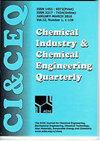因子设计与表面法优化鸡废弃物生产乙基生物柴油
IF 0.8
4区 工程技术
Q4 CHEMISTRY, APPLIED
Chemical Industry & Chemical Engineering Quarterly
Pub Date : 2021-01-01
DOI:10.2298/ciceq191117034s
引用次数: 1
摘要
要生产生物柴油,最重要的因素之一是生产中使用的油的质量。然而,其他因素,如价格和可用性也应该考虑在内。鸡肉废油显示了一个非常有前途的选择,因为它来自废物。本研究的目的是通过乙基酯交换法提取和表征鸡废油生产生物柴油的方法,并对生产生物柴油的工艺变量进行表征和优化,以及涉及CCD的RSM的应用。对油的表征参数进行了评估:粘度、密度、酸度指数、样品水分、折射率和皂化指数。对生物柴油的粘度、密度、酸度指数和酯含量进行了评价。在催化剂质量浓度为2.1%、油乙醇比为1:5.5、反应温度为30℃的条件下,制备鸡用生物柴油的最佳条件;那时,转化率达到了95%。在统计技术得到的p值为0.05的最佳点上,生物柴油的物理化学特性的结果可以在ANP标准中找到。本文章由计算机程序翻译,如有差异,请以英文原文为准。
Factorial design and surface method to optimization ethylic biodiesel production from chicken wastes
To produce biodiesel, one of the most important factors is the quality of the oil used in the production. However, other factors such as price and availability should also be taken into consideration. Chicken wastes oil shows a very promising option for this sector, since it comes from a waste. The aim of the present study was a methodology for extraction and characterization of chicken wastes oil for production of biodiesel by ethylic transesterification, besides presenting the characterization and optimization of the process variables of the production of biodiesel, the applying of RSM involving CCD. The investigation was performed following evaluation of the characterization parameters for the oil: viscosity, density, acidity index, moisture of the sample, refractive index, and saponification index. For biodiesel, viscosity, density, acidity index and ester content were evaluated. An optimum point was reached for the production of chicken biodiesel where the concentration of the catalyst is 2.1% by mass, the oil/ethanol ratio is 1:5.5 and the reaction temperature of 30 ?C; at that point, a 95% conversion was achieved. At the optimum point obtained from the statistical technique for a p-value of 0.05 the results found for the physical- chemical characterization of biodiesel are found in the ANP standards.
求助全文
通过发布文献求助,成功后即可免费获取论文全文。
去求助
来源期刊

Chemical Industry & Chemical Engineering Quarterly
CHEMISTRY, APPLIED-ENGINEERING, CHEMICAL
CiteScore
2.10
自引率
0.00%
发文量
24
审稿时长
3.3 months
期刊介绍:
The Journal invites contributions to the following two main areas:
• Applied Chemistry dealing with the application of basic chemical sciences to industry
• Chemical Engineering dealing with the chemical and biochemical conversion of raw materials into different products as well as the design and operation of plants and equipment.
The Journal welcomes contributions focused on:
Chemical and Biochemical Engineering [...]
Process Systems Engineering[...]
Environmental Chemical and Process Engineering[...]
Materials Synthesis and Processing[...]
Food and Bioproducts Processing[...]
Process Technology[...]
 求助内容:
求助内容: 应助结果提醒方式:
应助结果提醒方式:


